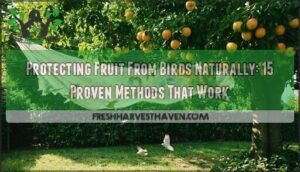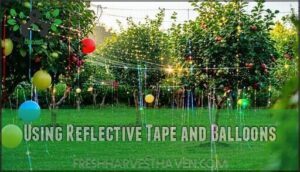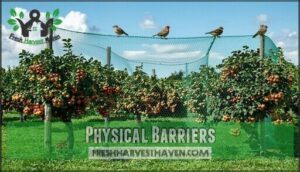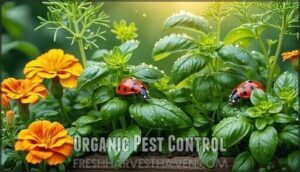This site is supported by our readers. We may earn a commission, at no cost to you, if you purchase through links.

Install fine mesh netting over trees and bushes – it’s your most reliable defense.
Set up reflective tape, old CDs, or aluminum pie pans that flutter and flash in the breeze.
Deploy decoy owls or hawks, moving them weekly so birds don’t catch on.
Plant mint, basil, or hot peppers nearby as natural deterrents.
Create homemade sprays using garlic, chili, or cinnamon mixed with water.
Row covers work perfectly for smaller plants, while bird-proof cages protect individual fruit clusters.
The key is combining multiple strategies and staying one step ahead of these clever thieves, using a combination of these methods as your best protection.
Table Of Contents
- Key Takeaways
- Natural Bird Deterrents
- Fruit Tree Protection
- Bird Repellent Plants
- Homemade Bird Repellents
- Physical Barriers
- Organic Pest Control
- Frequently Asked Questions (FAQs)
- How do farmers protect fruit trees from birds?
- Does vinegar keep birds away from fruit trees?
- When do birds typically damage fruit most?
- Which bird species cause the greatest fruit damage?
- How to protect fruit trees during harvest season?
- What timing works best for bird deterrent installation?
- Do bird protection methods affect fruit quality?
- Conclusion
Key Takeaways
- You’ll get the best results by combining multiple deterrent methods rather than relying on just one – mix netting with reflective tape, decoy predators, and sound devices to stay ahead of these clever birds.
- Physical barriers like fine mesh netting and bird-proof cages offer your most reliable protection, creating an impenetrable shield that works 24/7 without needing constant maintenance or replacement.
- You can create effective natural repellents using household items – plant hot peppers, mint, and basil around your trees, or make homemade sprays with garlic, chili, and cinnamon mixed with water.
- Timing is crucial for success – install your deterrents 2-3 weeks before fruit ripens and move visual deterrents like decoy owls weekly to prevent birds from getting used to them, using multiple deterrent methods and effective natural repellents.
Natural Bird Deterrents
You can protect your fruit trees from birds using three proven visual and audio deterrents that work without harmful chemicals.
These methods include traditional scarecrows with reflective materials, protective netting systems, and sound-based devices that create an unwelcoming environment for hungry birds.
Using Visual Scarecrows
Visual scarecrows remain your first line of defense against fruit-stealing birds when you understand their science.
Traditional designs work best with strategic upgrades that exploit birds’ natural fear responses. Effective use of visual scarecrows involves understanding visual deterrents to maximize their impact.
Here are three proven scarecrow techniques:
- Shiny Reflectors and Movement – Attach reflective tape, old CDs, or aluminum pie plates to create dancing light patterns that trigger avoidance behaviors in most bird species.
- Fake Predators with Realistic Features – Use owl or hawk decoys with painted eyes and rotate positions every few days to prevent habituation among intelligent corvids.
- High-Contrast Scarecrow Designs – Combine bright orange clothing with silver accessories to maximize visual impact, especially effective against songbirds during peak feeding times.
Installing Netting Barriers
Netting Materials form your frontline defense against feathered fruit thieves. You’ll need quality bird netting with 3/4-inch mesh to keep birds out while allowing sunlight through.
Install Netting Frames around individual trees or entire garden sections for maximum Fruit Coverage.
| Netting Type | Best Use |
|---|---|
| Fine mesh (1/4") | Small berries, grapes |
| Medium mesh (3/4") | Apples, pears, stone fruits |
| Heavy-duty plastic | Large fruit trees |
| Temporary fabric | Quick seasonal protection |
Proper Barrier Installation requires securing edges tightly to prevent birds from sneaking underneath. Garden Mesh works best when draped loosely over fruit tree netting frameworks, creating air pockets that won’t damage branches.
These natural bird deterrents offer reliable fruit protection methods without harmful chemicals. To guarantee the longevity of your fruit trees, consider implementing fruit tree winter protection strategies in conjunction with netting.
Utilizing Noise Making Devices
Beyond traditional scare tactics, sonic bird deterrents offer high-tech protection for your fruit trees.
Ultrasonic repellents emit frequencies that irritate birds without disturbing humans.
Sonic bird devices play predator calls or distress signals on timers.
Wind chimes create random noise patterns that keep birds guessing.
These audio scarers work best when rotated regularly to prevent habituation in your bird-friendly gardening approach.
Fruit Tree Protection
Protecting your fruit trees requires strategic physical barriers that create effective shields against hungry birds.
Tree guards wrap around trunks to prevent climbing access, while fruit bags cover individual fruits or clusters.
Bird spikes installed on branches discourage perching without harming wildlife.
Consider these proven fruit tree protection methods:
- Install bird proof netting over entire canopies for thorough coverage
- Use crop covers made from lightweight fabric that allows sunlight penetration
- Apply orchard fencing around tree perimeters with small mesh openings
- Position reflective tape strips throughout branches to create visual deterrents
These bird repellent methods work best when combined with proper timing – install barriers before fruits ripen to establish boundaries early.
Effective pest management also involves understanding common pest issues to guarantee overall tree health.
By using these methods, you can ensure the overall protection of your fruit trees and enjoy a bountiful harvest, which is the ultimate goal of fruit tree protection and effective pest management.
Bird Repellent Plants
You can naturally discourage birds from targeting your fruit trees by strategically planting specific herbs and vegetables that birds find unappetizing.
These companion plants create a natural barrier around your fruit trees while adding useful crops to your garden, making them a valuable addition by being useful crops.
Planting Hot Pepper Varieties
Hot peppers create powerful bird repellent methods through capsaicin compounds that naturally deter fruit raiders without harming them.
Capsaicin compounds naturally deter birds without harm – nature’s spicy solution for fruit protection.
Plant cayenne, jalapeño, or habanero varieties around your fruit trees for effective natural pest control and organic gardening tips.
| Pepper Variety | Capsaicin Level | Deterrent Range |
|---|---|---|
| Cayenne | High | 15-20 feet |
| Habanero | Very High | 20-25 feet |
| Ghost Pepper | Extreme | 25-30 feet |
Start pepper seedlings in early spring for ideal garden planning.
Hot pepper care involves regular watering and full sun exposure.
Your pepper harvest doubles as spice blends while protecting crops.
This eco friendly bird repellent outperforms bird proof netting in rainy climates.
Using Garlic and Chili Sprays
Garlic spray creates a powerful natural barrier that birds can’t stand.
Mix crushed garlic cloves with water, strain, and spray directly on ripening fruit.
Chili peppers boost the deterrent effect – blend hot peppers into your garlic solution for double protection.
These organic pesticides won’t harm your plants while delivering effective bird control methods that keep feathered thieves away from your harvest, utilizing a natural barrier.
Incorporating Mint and Basil
Mint benefits extend beyond culinary uses—these aromatic plants naturally deter birds through their strong scent.
Plant spearmint or peppermint around fruit trees for effective natural bird control.
Basil uses include companion planting near vulnerable crops, and both herbs support bird friendly gardening while serving as natural pesticides.
This herb gardening approach complements garden netting systems and other bird repellent plants for thorough fruit tree bird guards.
Homemade Bird Repellents
You can create effective homemade bird repellents using common household items that won’t harm your fruit trees or the environment.
These DIY solutions offer cost-effective alternatives to commercial products while protecting your harvest naturally.
Creating Sugar Water Sprays
When birds discover your fruit trees, sugar water sprays create sticky barriers that deter them without harm.
Mix one part sugar with three parts water, adding a few drops of dish soap for better adhesion.
These Sugar Spray Recipes work as effective Bird Deterrents by making fruit surfaces unpleasant to land on.
The sticky coating preserves Fruit Protection while remaining safe for Natural Preservatives approaches in bird friendly gardening systems.
Using natural methods like gardening pest control can also help protect your fruit from other pests.
Making Homemade Bird Seed
Creating your own bird seed blend offers a strategic approach to natural bird control strategies.
Instead of purchasing expensive commercial mixes filled with unwanted fillers, you’ll craft targeted seed recipes that redirect birds away from your fruit trees.
Focus on seed mixing techniques using millet, cracked corn, and sunflower seeds – ingredients that provide proper bird nutrition while keeping feathered visitors satisfied elsewhere.
Store your homemade blend in airtight containers for ideal seed storage, then use simple feeder designs placed far from your fruit trees for effective bird friendly gardening.
Using Reflective Tape and Balloons
Visual drama transforms your garden into a bird-free zone with strategic placement of shiny tape and reflective strips.
These visual deterrents create flashing ribbons of light that confuse and redirect feathered visitors.
Hang bird balloons and reflective bird deterrents from branches, combining them with garden netting for maximum protection.
These natural bird control methods work best when moved regularly to prevent habituation.
The use of reflective bird tape products, such as those found in bird deterrent systems, can enhance the overall effectiveness of these natural methods.
Physical Barriers
When birds discover your ripening fruit, they’ll return daily until nothing remains. Physical barriers offer the most reliable protection, creating an impenetrable shield between hungry birds and your harvest.
**Persistent birds will strip your trees bare—only physical barriers guarantee complete harvest protection.
Installing Bird-Proof Fencing
Permanent fencing creates an impenetrable fortress around your fruit garden.
Choose fence materials like galvanized mesh or electric netting based on your specific bird control needs.
Proper fence height of 6-8 feet with 1/4-inch mesh size prevents most birds from accessing your harvest.
Install posts every 6-8 feet for maximum stability.
This bird proof gardening method delivers long-term fruit tree protection without chemicals.
Effective wildlife exclusion methods, such as using wildlife proof fencing, can also be applied to protect your garden from other pests, providing a form of wildlife exclusion and creating a bird proof environment.
Using Row Covers and Individual Sleeves
Row covers and garden mesh offer lightweight fruit protection without permanent installation.
You’ll wrap individual fruits in breathable sleeve materials or drape entire branches with specialized crop protection fabric.
These natural deterrents allow air circulation while blocking bird access.
Garden netting works well for smaller trees, while individual fruit wrapping protects specific clusters.
Both methods provide effective bird control during peak ripening seasons, using breathable sleeve materials and specialized crop protection fabric.
Creating DIY Bird-Proof Cages
When building your own fortress of wire mesh, you’ll transform ordinary materials into powerful garden bird protection systems.
Custom cage materials like hardware cloth or chicken wire create non toxic bird control that outlasts store-bought options.
- Frame Designs: Use PVC pipes or wooden stakes for lightweight, adjustable structures
- Wire Mesh Options: Choose 1/4-inch hardware cloth over larger netting options for small bird species
- Cage Sizes: Build modular sections that expand as your fruit garden security needs grow
These homemade bird scare systems beat expensive alternatives while giving you complete control over your harvest protection.
Organic Pest Control
Smart gardeners know that organic pest control creates a balanced ecosystem where beneficial creatures help protect your fruit naturally.
You’ll discover how attracting the right allies and using earth-friendly treatments can reduce bird damage while supporting your garden’s overall health.
Attracting Beneficial Birds and Insects
You’ll find that working with nature beats fighting against it every time.
Create pollinator gardens with native flowers that attract beneficial wasps and predatory insects to handle garden pest management naturally.
Install insect hotels near fruit trees to house these helpful allies.
This bird friendly approach supports garden ecology while providing ecofriendly pest control that reduces problematic bird populations through natural bird behavior management.
Using Diatomaceous Earth and Kaolin Clay
Diatomaceous Earth and Kaolin Clay offer dual benefits for fruit crop protection.
Diatomaceous Earth alters fruit surface texture, making it less appealing while controlling soft-bodied pests.
Kaolin Clay creates effective Natural Barriers through Clay Coatings that reduce bird damage by up to 50%.
These Organic Sprays provide ecofriendly pest control without toxicity concerns, supporting thorough natural gardening strategies.
Effective organic pest control methods are essential for maintaining a healthy and balanced ecosystem in gardens.
Implementing Crop Rotation and Sanitation
Through proper crop planning and farm hygiene, you’ll reduce bird pressure substantially.
Clean fields remove food sources that attract birds, while strategic harvest timing minimizes exposure during peak feeding periods.
Key rotation and sanitation practices:
- Soil Management – Remove fallen fruit immediately to eliminate bird attractants and breeding grounds for pests
- Field Preparation – Clear debris between growing seasons and rotate crops to break pest cycles naturally
- Harvest Timing – Pick fruit at prime ripeness before birds discover your garden’s bounty
- Farm Hygiene – Maintain clean growing areas as part of thorough organic gardening and natural bird control strategies
Frequently Asked Questions (FAQs)
How do farmers protect fruit trees from birds?
You’ll need multiple strategies to outsmart these feathered thieves.
Try netting, reflective tape, decoy predators, or harvest timing adjustments.
Row covers work great for smaller trees, while noise makers help too.
Does vinegar keep birds away from fruit trees?
Like a chef’s secret ingredient that birds instinctively avoid, vinegar creates an acidic environment that disrupts their taste preferences.
You’ll find white vinegar works moderately well as a deterrent, though you’ll need frequent reapplication after rain and consistent coverage for meaningful results.
When do birds typically damage fruit most?
Birds cause the most damage when your fruit reaches peak ripeness – that sweet spot you’ve been waiting for.
They’ll typically strike during early morning hours and late afternoon, targeting stone fruits like peaches and cherries first.
Which bird species cause the greatest fruit damage?
Crows, ravens, starlings, and robins top your problem list. These clever raiders work in flocks, targeting ripe berries and stone fruits with surgical precision, often stripping entire crops overnight.
How to protect fruit trees during harvest season?
Harvest timing matters most – pick fruit at peak ripeness before birds discover it’s ready. Use reflective tape, decoy predators, and temporary netting during critical ripening weeks for maximum protection.
What timing works best for bird deterrent installation?
Install deterrents 2-3 weeks before fruit ripens. You’ll beat the birds to the punch when they start scouting. Early installation lets birds adjust their foraging patterns elsewhere.
Do bird protection methods affect fruit quality?
Properly installed physical barriers actually improve fruit quality by 15-20% compared to chemical treatments.
You’ll maintain natural ripening conditions while preventing bird damage that creates entry points for rot and insects, which is a key factor in improving overall fruit quality by using physical barriers.
Conclusion
Absolutely nothing beats the satisfaction of protecting fruit from birds naturally when you’ve got the perfect arsenal at your disposal.
You’ve learned fifteen battle-tested methods that’ll keep those feathered bandits away from your precious harvest.
Mix and match these strategies—combine netting with reflective tape, plant deterrent herbs near bird-proof cages, and rotate your decoy placement regularly.
Remember, consistency is your secret weapon, and when protecting fruit from birds naturally, persistence pays off with sweeter rewards.









